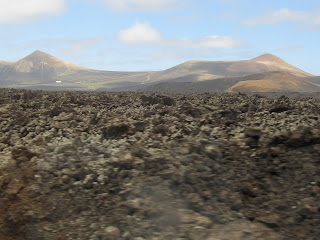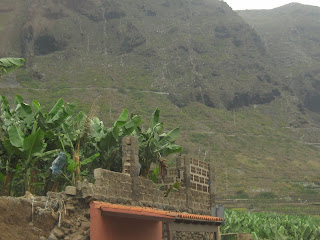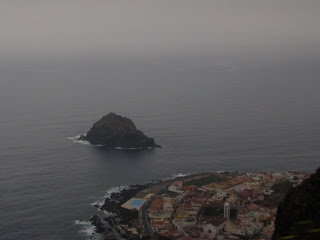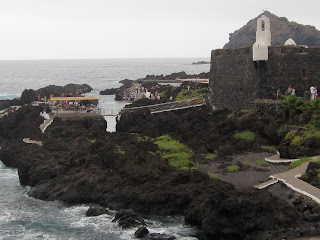It is an excellent forecast to sail to the Canary Islands. We are pleased to learn that the forecasts for the Atlantic are usually reliable, not unpredictable like in the Mediterranean.
We leave Safi in Morocco with a slight swell and sailing averaging 6.7kts. which is very pleasant. A large pod of dolphins join us for some distance.
We can sail through the night averaging about 7 kts. with the wind mostly on the beam and variable wind speeds. We had to reduce the headsail at one stage. The swell came up to a couple of metres but with wind on the beam it was comfortable.
The full moon came peeping through the previously overcast sky at mid-night to brighten up the sky and reflect over the sea.
The rest of the trip across to the Canary Islands to Puerto Calero at Lanzarote Island, is much the same, with periods of not enough wind to counteract the swell, but often enough on the beam to do so. There is not always enough wind to sail but we are able to for about 60% of the trip.
We are pleased to arrive here at 9.30am Monday morning. We both feel as though we have a triple doss of jet lag but after washing down the boat and a siesta after lunch ashore, we feel back to normal.
Canary Islands
This group of volcanic islands emerged up to 16 to 20 million years ago and are situated off the n.west coast of Africa. They are a province of Spain with some legislative autonomy.
In the middle ages they were believed to be the western limit of the world, and were visited by Arabs, Portuguese and French. Their indigenous inhabitants, the Guanche and Canario were gradually conquered during C15.
The islands became a stop on the usual route for Spanish trading vessels with the New World.
We arrive at Lazarote Island about 9.30am. We have been warned Arrecfe is not a pleasant port (thanks to Phil and Robbie) so we come directly into the new Puerto Calero which is a very attractive and welcoming place. The water here is clear, which is because it is 8-10m deep and and they have built openings in the exterior wall to allow a constant flow of fresh water.
Impulsive is soon gleaming again and we wander ashore for a late lunch at one of the many waterside restaurants. We really enjoy this light, fresh and healthy meal. Provisioning was impossible in Morocco because of the heat and the distance to the market and shops from the boat. Also the difficulty of disembarking and embarking meant I needed 2 men to help me, or strong people to put the gang plank across. Also the shore passes is always an issue which is frustrating.They won´t let a taxi driver in and it is still a long walk to Impulsive. We would like to have walked to the fresh fish stall but have all the same issues.
The promenade here is lined with palm trees and we immediately feel a holiday atmosphere about the place. Apparently it becomes very busy in October when the yachts start arriving to prepare for the ARC (the Atlantic Rally Crossing). Ross spoils me here with some lovely new clothes! It will be fun to wear them while Scott, Jeanette and the girls are with us.
We like this island which has been a Biosphere reserve since 1993.. We spend a full day exploring by car. All the towns seem to have white-washed houses all conforming to a similar cubic design. Some have attractive colours for their trims eg Lanzarote green shutters and doors. They make such a contrast to the black/blue volcanic rock and soil, the rock fences and the blue sea off the coastline. Many of the median strips are impressively lined with strelizia ( bird of paradise). We by-pass Arrecefe and enroute have wonderful views over the sea with the foreground of volcanic and barren flats and slopes.
There are two weather issues experienced here. Firstly the northern aspects of the islands are often under cloud which forms from the moisture condensing at the mountains Also because of the height of these mountains the north-east prevailing wind is often accelerated as it funnels in gusts between the islands, and without much warning. Secondly the red Sahara dust comes across with the easterly or n.easterly winds at least weekly and settles on everything, including boats!
Visiting Jameos del Agua is the beginning of our understanding of the great influence Cesar Manrique has had on Lazarote. His artistic works whether it is his paintings, urban planning, sculptures or public art is all to find an integration with the natural surroundings and to search for harmony for life itself. eg with town planning he encouraged the enforcement of only allowing buildings of a certain height to be built, and controlling development for tourism.
Jameos del Agua is an amazing site developed in a tunnel created by a volcanic eruption, and with its internal lake formed by sea water seeping in through the rock below sea level .There is an under ground auditorium and restaurant. His use of recycled wood from an old ship and the volcanic rock, along with the landscaping, give a unique setting.
 Grotto at Jameos del Agua
Grotto at Jameos del Agua
 Stool carved out of volcanic rock
Stool carved out of volcanic rock Pool at the grotto
Pool at the grotto View looking back across typical village with white washed houses.
View looking back across typical village with white washed houses.Foundacion Cesar Manrique is the house the artist built on the C18 lava flow, following his ideas of living in harmony with nature. He lived here for twenty years. Now it is used as a museum.
 Cezar Maniques´Foundacion
Cezar Maniques´Foundacion
A simple water fountain
 A room designed in a bubble of the volcanic tunnel
A room designed in a bubble of the volcanic tunnel Small bridge made out of volcanic rock over a small pool in a courtyard
Small bridge made out of volcanic rock over a small pool in a courtyardTeguise, once the capital city, is further inland, and is a very attractive town to visit. It dates from the mid C15. We enjoy an amble through its main square and along some of its cobbled streets.
 Main square at Teguise
Main square at TeguiseYaiza is a picturesque small town. It has some beautifully restored C19 houses in its tree -lined streets.
 Our table at the restaurant at El Golfo
Our table at the restaurant at El GolfoLunch at El Golfo on the south west coast sitting at the water´s edge at the Bogavante restaurant which is built on volcanic rocks, is a lovely experience. It has great views of the rugged coastline here. A semi-precious green stone, olivine is found in this area.
 Looking across Montanas del Fuego
Looking across Montanas del Fuego
Camel trekking - seen from the bus
Montanas del Fuego is north of here We take the bus trip to see some of the area affected by the volcanic eruptions in the C18 and in 1824. A quarter of the island is still buried by thick layers of lava and ash. Imagining the force of these eruptions and trying to visualize them is quite awesome. We saw some filming of volcanoes at the museum. The whole scene now looks like a moonscape.
 Montanas del Fuego
Montanas del Fuego
A large crater
We continue on along the south west coast to Los Hervidero, which is very rugged , with its high cliffs and grotto, and then the south coast to Papagyo, an attractive coastal town. It is the southern most point of Lanzarote.
 South-west coast (volcanic rock)
South-west coast (volcanic rock) Grotto at Los Hervidero
Grotto at Los HervideroPuerto Calero is one of the best marinas we have stayed at. Helpful, friendly staff, everything is clean, and workers are efficient and competent who come to the boat at the appointed time. The young woman in the office is a breath of fresh air. She picks up some new rubber stoppers for us when she drives into Arrecfe, organizes an electrician to fix the broken lead for the salt-water pump, and translates for Ross.
Provisioning isn´t looking very promising here but fresh supplies come into the marina supermarket mid-morning, including fresh bread.
It is a 12 n.mile motor-sail with quite a swell s.west across to El Puertito at Isla de Lobos . We anchor on the southern side in the lee of the land with a bit of protection from the swell. When the wind comes round 180 degrees to the north we hope it stays as it is counteracting the swell. We enjoy the peace of this tiny island and are the only boat here overnight. A walk ashore at sunset around the lagoon on this volcanic island is lovely. Slowly the other boats leave and the fishermen on the jetty retire to the cottages around the corner.


Anchored at Ilsa de Lobos (Fuerteventura Is. in the background)
 Walking back to the dinghy
Walking back to the dinghy
Moon rising over the lagoon
The water here is a beautiful turquoise and crystal clear to swim in. We have been missing our daily swims since we left the Mediterranean.
This island is off the n.east tip of Fuerteventura Island. This morning we leave to track along Fuerteventura´s southern coast. There are many beaches and resorts along here . We pass by bare hills and later with the backdrop of high mountains all covered by a haze. Another overcast day, and cool for sailing.
We have an early lunch because when we follow the coast and change course to a westerly direction, Ross is organized to fly the spinnaker which we are looking forward to. Unfortunately we think we strike an acceleration wind zone, even though it is not marked on the chart, and so are not able to do it. These areas are usually marked on the chart and show where increased wind speeds force large masses of air through the channels separating the islands. These accelerations occur without much warning and can increase the wind speed dramatically.
Instead we enjoy a lovely sail averaging 7.5 kts. with a reduced mainsail and headsail. The winds here are very unpredictable. Soon the wind drops and we can fly the spinnaker. Ross uses his new pulley system, to protect his back, and it is very successful although he hoped it would give him more mechanical advantage than it has.
 Flying the spinnaker
Flying the spinnaker
An incredible cloud formation as we track along the south coast

Barren cliffs further along the Fuerteventura coast
The wind is quite strong now so it takes us some time to anchor securely. The young man decides we are close enough in for him to swim ashore. We let him go ahead as we don´t want to leave the boat in this wind, and using the dinghy would be difficult. We watch him with the binoculars until we see him walk up the fishing ramp. This is a tiny village but in no time there seem to be people lining the cliff top, a police car and coast guard van all surveying the scene. We did understand this fellow to live near by. Next a helicopter is flying low over the sea in the area so the alert must have gone out that he was missing.
Barren cliffs further along the Fuerteventura coast
It has been a long day´s sail and we are looking forward to anchoring as we approach Morro Jable on the s.west tip of the island.
We have an incredible experience as we come in. There is a fish farm here and watching out closely for buoys I call Ross because there is a swimmer waving at us quite frantically. He is along way from the shore. We go over to him and he obviously is in trouble and is pleased to come aboard. His english is very limited but he explains something about his friend forgot him. Whatever the reason he was concerned about his survival, especially as it wasn´t long until dark. He had a wet suit, flippers and goggles so he had intended to swim.
Sometime later he came by in a flash run-about boat and thanked us again as he went on to the cove nearby where he lives.
 Leaving Morro Jable
Leaving Morro JableWe have a settled night and set off at day break across the passage to Gran Canaria.. The wind is on the beam, averaging 10-16 kts. and we are able to sail most of the way with the headsail and reduced mainsail. As we approach an accelerated wind zone on the chart Ross reduces the headsail as well. It is another overcast day.
The swell is coming directly behind us , so is no problem. We are pleased not to experience any accelerated winds. Approaching the southern coast of Gran Canaria it is almost hidden in haze.
The cloud has lifted and the sea is a wonderful deep blue as we come into Puerto de Mogan nestled amongst very high, striated cliffs.
 Approaching Puerto de Mogan
Approaching Puerto de Mogan
Coming into Puerto de Mogan
Now we can prepare for Scott, Jeanette, Augusta and Lily to arrive tomorrow.
Saturday, July 31st.
It is very exciting to hear voices we know so well arriving at the boat, and then to see those beautiful smiling faces.
Scott chose Puerto Mogan , on the s.west coast, to meet us as it it a small fishing village. It has kept its village atmosphere and is very attractive with its simple Mediterranean architecture and white-washed buildings. Shops and cafes surround the port´s waterfront. In the evening the apartments above the shops open their deck doors and this gives a lovely glow as they turn on their lights. They have flat roofs with colourful plants cascading over the edge. There are tropical plants in abundance throughout the town, including bougainvillea, oleandas and birds of paradise. Waterfront at Puerto Mogan - view from Impulsive
Waterfront at Puerto Mogan - view from Impulsive
 Waterfront at Puerto Mogan - view from Impulsive
Waterfront at Puerto Mogan - view from Impulsive
View from the stern of Impulsive
 Tropical flower growing near Impulsive´s berth
Tropical flower growing near Impulsive´s berthThis is a very quiet town, especially early in the morning. Nothing seems to happen here until 10.am. We enjoy this time of day because it is always cool and makes it easier to shop and work on the boat. It is extremely easy to feel in holiday mode here. Everyone seems relaxed and friendly. The streets near the waterfront are for pedestrians only.
The old town rises up behind the port, and looks as though it is cut into the volcanic rock.
The beach here is very attractive and well maintained. It becomes busier as the day gets hotter.
Scott an Jeanette´s apartment is near the far end of the beach amongst some modern buildings. It is only a 10 minute walk from Impulsive. These apartments have a swimming pool which is a great asset for Augusta and Lily during the heat of the day.
We have the most wonderful week enjoying short sails, swimming off the boat, dinghy exploits, the beach, snorkeling, swimming in the pool, and dining on Scott and Jeanette´s terrace or on Impulsive. This way the girls can go to bed when they are ready after sun drenched days filled with activities. We had some brunches out instead which is more successful. We only had dinner out once and Lily fell asleep even before our main course was served. Augusta and Lily stay on board with us for 2 nights, which is great fun.
 Scott and Jeanette swimming off the back of Impulsive in a small cove
Scott and Jeanette swimming off the back of Impulsive in a small cove
Augusta and Lily
 Augusta concentrating at the helm
Augusta concentrating at the helm In the dinghy off Puerto Mogan beach
In the dinghy off Puerto Mogan beach Jeanette and Augusta
Jeanette and Augusta Lily dancing with Farfar
Lily dancing with Farfar Farfar flipping pancakes for breakfast on Impulsive
Farfar flipping pancakes for breakfast on ImpulsiveAugusta and Lily had a great time improving their swimming skills and having a relaxing time before they return to school and kinder next week.
Scott, Jeanette and the girls arrive the weekend of the fishermen´s festival. This begins on Saturday morning with loud music and singing over at the fishermen´s wharf. At lunch time the boats decorated with flags start leaving the port, each with many people on them and sounding very festive still with their music and singing. It is all quite a spectacle.
 Fishermen´s festival
Fishermen´s festival
Fishermen´s festival
 Party boat coming in next to impulsive
Party boat coming in next to impulsive Fishermen´s part boats rafted up near impulsive in the small cove
Fishermen´s part boats rafted up near impulsive in the small coveThey all come back into the harbour later for a barb-e-que, and still continue with the music and singing. This is all to promote a good fishing season for the next year.
This culminates at mid-night with a fantastic fireworks display from the beach area and just outside the cove. It is quiet when we return to Impulsive but Scott and Jeanette tell us the partying continues for hours in the main square.
Sunday is a repeat day of yesterday. We venture out on Impulsive to a nearby cove for sailing, swimming and snorkeling and some of the party boats come here. This is a small, picturesque cove with magnificent water to swim in. A highlight here is to feed the masses of sardines with bread. They actually jump above the surface of the water. The climate is perfect here for this sort of holiday, with cool mornings, hot days for water activities and balmy warm evenings. With the hot winds coming across from the Sahara Desert there is a warm climate here all year round with the temperature averaging 18-24 degrees.
Every Friday there is a market of at least 100 stalls around the perimeter of the port. It is a great experience to go to the market with Jeanette who is always looking for new ideas for her label and business. She is pleased to find some beautifully made shawls from South America, which are leather pieces stitched together with crochet by hand. She is sure she can sell these in Denmark for a good price so tries to enter into some sort of business plan with the seller. Unfortunately he is not much of a business man so it will be interesting to see what the outcome is.
We have some fun buying clothes and accessories for Augusta and Lily, and for the grandchildren at home. Jeanette has a marvelous eye for these things, and she is good at bargaining.
 The latest fashion in sunglasses, from the market!
The latest fashion in sunglasses, from the market!We are always sad to farewell Scott, Jeanette, Augusta and Lily back to Denmark, but we have had the most wonderful time with them all, and all feel very relaxed. Fortunately we are visiting them for a few days on our way home to Australia in a few weeks.
favourite recipe this leg :
1 whole fresh salmon cleaned and filleted by the fish monger - he would only sell it whole so we freeze what we don´t need
Marinade with lime juice and sprinkle with herbs, including coriander, and spices
Then barb -e -que
Serve with barb -e -qued vegetables; eggplant , zucchini and pumpkin (finish off in the microwave if necessary). Sprinkle with fresh herbs
And a salad including mixed lettuce, cherry tomatoes, cucumber, goats cheese and avacado; dress with balsamic vinegar and olive oil, and parsley.
Also serve with a small platter of asparagus.
















































